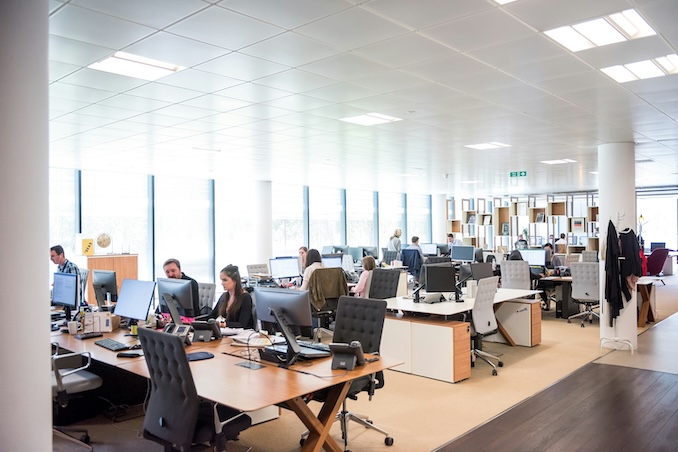Creating a truly great workplace is surely the goal for every business leader. Of course, it can be a challenge to get the recipe right. A great workplace isn’t just about high productivity, growth, and revenue, it’s also about creating an environment where employees feel valued, motivated, and empowered to grow. Lawrence Krimker, a Toronto entrepreneur and business leader, has built and led award-winning teams by focusing on the core elements that contribute to a positive and productive culture. Having led a company that was recognized six years in a row as one of Canada’s best places to work, Krimker offers a unique perspective on what makes a workplace truly great.

Give Employees the Freedom to Thrive
For Krimker, a great workplace starts with empowering employees. Empowerment gives people the autonomy to make decisions, take ownership of their roles, and bring their ideas to the table. When people have the freedom to approach challenges in their own ways, they are more invested in their work and more likely to bring innovative solutions. In Krimker’s view, empowerment leads to higher morale, better problem-solving, and a more engaged workforce. Leaders can encourage empowerment by providing resources, offering guidance, and allowing employees the space to excel.
Empathy and respect
Krimker firmly believes empathy and respect are the building blocks of a great workplace. He believes that leaders who genuinely understand and care about their team members’ perspectives, challenges, and aspirations create a more supportive and inclusive work environment. This approach, he says, fosters a sense of mutual respect and trust, making employees feel valued and understood. He sees empathy as crucial for connecting with staff on a personal level, which can strengthen team bonds, increase employee engagement, loyalty, and overall job satisfaction, which positively impacts the entire organization.
Clear and Transparent Communication
Transparent communication is another essential element of a great workplace. Employees need to feel informed about the company’s goals, challenges, and successes. When people understand where the company is headed, they feel a greater sense of purpose in their roles, Krimker says. Clear communication also minimizes misunderstandings, reduces stress, and keeps everyone aligned.
Opportunities for Growth and Development
A great workplace provides ample opportunities for growth and development, with a clear structure that employees understand. People want to know they’re making progress in their careers and acquiring new skills. Leaders who take an interest in their employees’ growth create an environment where people feel challenged and valued. Training programs, mentorship opportunities, and clear paths for advancement are all ways to support employee development. When people feel they are developing personally and professionally, they are more likely to contribute positively to the organization and stay committed.
Recognize and Reward Achievements
A great workplace is one that acknowledges both big and small accomplishments. Recognition can be incredibly motivating, Krimker says. When people see their hard work being acknowledged, it reinforces that their contributions matter. Recognition can come in many forms, from formal awards to simple expressions of appreciation. Krimker notes that feedback should be a regular part of workplace interactions, as it helps people understand their progress and areas for improvement. Positive feedback not only motivates employees but also creates a supportive and uplifting atmosphere. Leaders who make recognition a priority can strengthen their team’s morale, build confidence, and inspire others to achieve more.
Align with a Shared Vision
Employees like to know their work is contributing to a larger purpose. By clearly articulating the company’s goals and values, leaders can help employees understand how their individual roles fit into the bigger picture. Krimker believes that leaders should endeavour to align their people on the organizational mission and values. A shared vision gives employees a sense of belonging and pride, and it fosters a culture of unity that’s essential for long-term success.
Work-life Balance
In today’s fast-paced work environment, flexibility is becoming increasingly important. Creating a workplace that supports work-life balance and understands the demands of life outside of work is important. A workplace that values work-life balance shows employees that their well-being is a priority. Employees who feel balanced are more focused, less stressed, and more likely to bring positive energy to their work.
Leadership’s Role
While each of these elements contributes to a great workplace, Krimker is quick to emphasize that leadership plays a pivotal role in bringing them to life. Leaders set the tone for the culture and are responsible for establishing the values and practices that create a supportive environment. A great workplace doesn’t happen by accident, it’s the result of intentional actions by leaders who prioritize their people. Leaders must be consistent in demonstrating the values they want to see in their teams. Whether it’s fostering open communication, recognizing achievements, or providing growth opportunities, Krimker believes leaders need to be actively involved in cultivating a positive culture.
Conclusion: Build a Workplace That Thrives
From fostering open communication to providing opportunities for growth, a great workplace supports its people and values their contributions. Leaders who invest in creating a positive culture not only enhance their team’s productivity but also create a space where people enjoy coming to work and feel motivated to do their best. Krimker’s insights reflect a modern, people-centred approach to leadership. He believes that when people feel supported, they’re more likely to contribute positively, remain loyal, and help the organization thrive. By focusing on these core elements, leaders can create a workplace that isn’t just successful, but also truly great.

